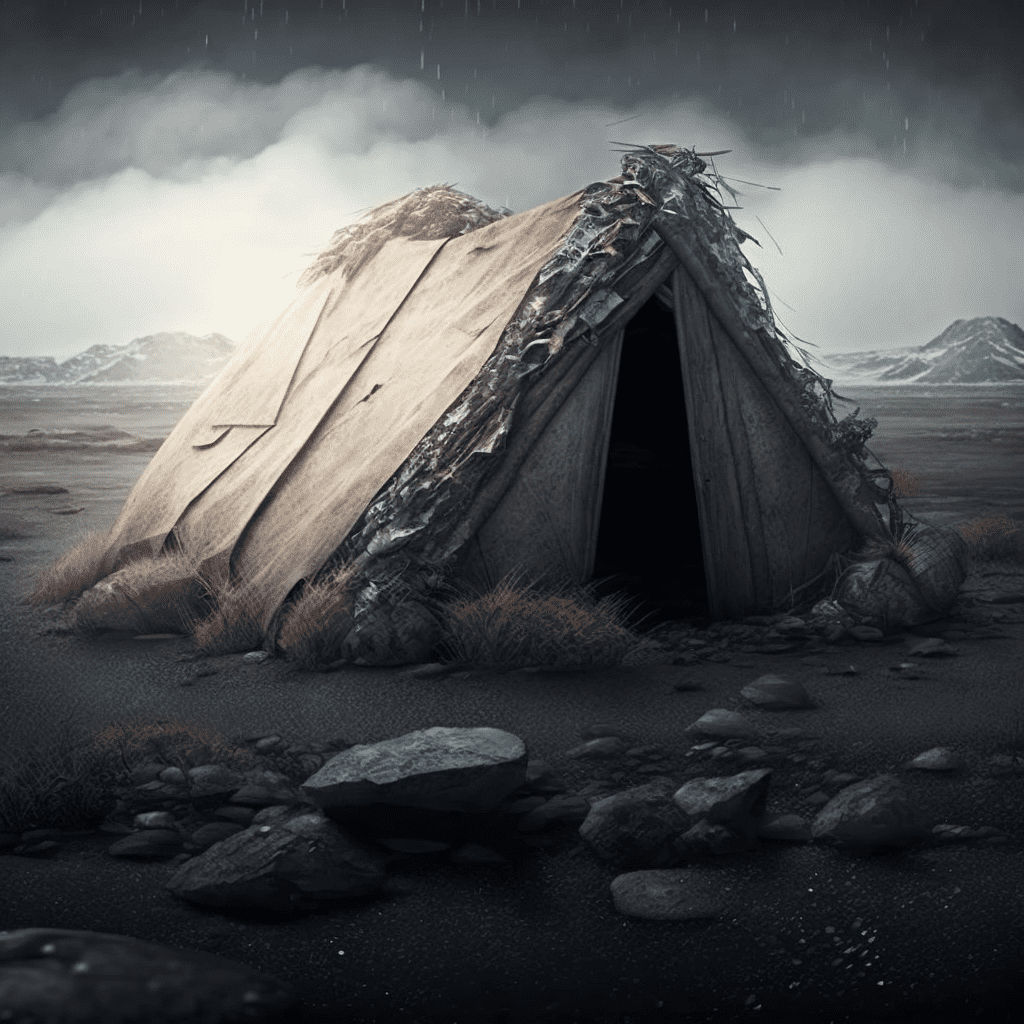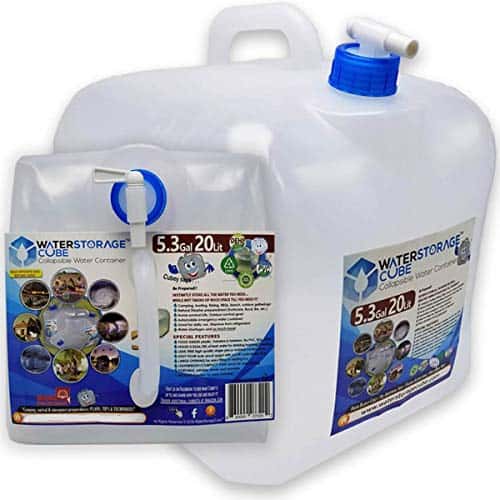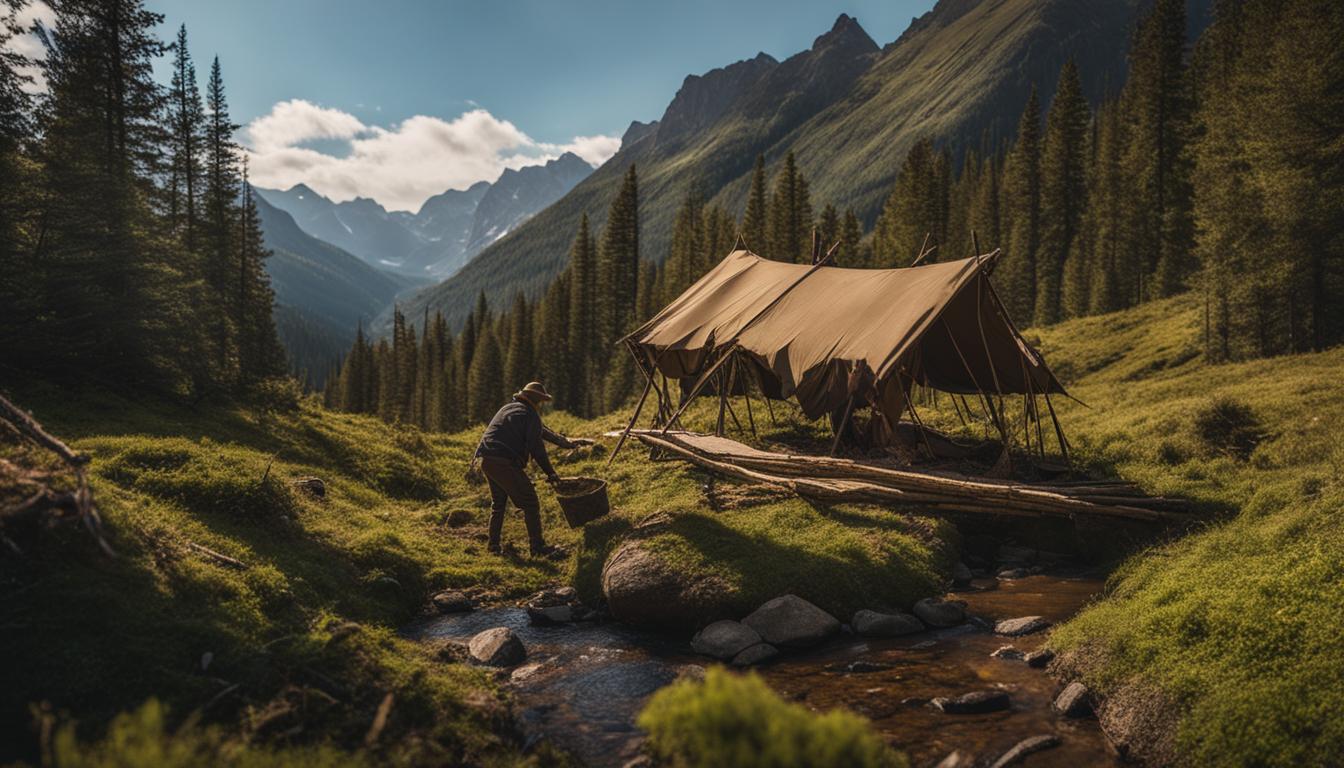Hello, SHTF survival enthusiasts! If you’re looking for the ultimate guide on building a shelter during a crisis, your search ends here. I’m ready to share some of my best advice on creating the perfect SHTF Survival Shelter to keep you safe and secure in emergency situations.
I’ve been surviving in tough situations since before most of us were born so let me tell ya, I know what works and what doesn’t when it comes to constructing your own place of refuge during a crisis. From choosing the right location to gathering the necessary materials, this article is packed with all the information you need to guarantee success.
So if you’re ready to take control of your safety and security in any scenario, then read on – because these lessons are guaranteed to make sure you’re always prepared when SHTF.
Definition Of SHTF
It’s the moment we all dread. SHTF – or “shit hits the fan” – is an ominous acronym for when everything goes wrong and our lives are thrown into chaos. It could be a natural disaster, economic collapse, pandemic, war, societal unrest, or any other event that leaves us without food, water, safety, and security. In such situations it’s absolutely essential to prepare in advance with proper training and supplies so you can survive whatever comes your way.
Survival experts know that having a secure shelter is key when SHTF. But what exactly does this mean? A survival shelter provides physical protection from external dangers like inclement weather and hostile forces while also providing psychological comfort by creating a safe space where one can rest assured of their basic needs being fulfilled. It must also include certain amenities like fireplaces or stoves for warmth and cooking as well as storage areas to store food rations and medical supplies.
The most important feature of any survival shelter is its ability to keep people safe from harm during an emergency situation. By building a sturdy structure out of quality materials that stands up against harsh elements and keeps predators out, you gain peace of mind knowing that no matter what happens outside your walls you have a place to stay protected until things get back on track again.
Types Of Survival Shelters
When it comes to survival shelters, there are numerous options to choose from. It all depends on the environment and resources available. I’m going to discuss three common types of shelters you could build in an emergency situation: debris hut, A-frame tent, and underground shelter.
The first type is a debris hut. This involves laying branches or logs over a structure like poles tied together at the top or between two trees for support. Then pile leaves, grasses and other vegetation onto the frame until it’s thick enough to provide insulation against cold weather. These huts can be built quickly but they require some material that may not always be readily available.
Next is an A-frame tent. These tents have become popular amongst preppers because they’re lightweight and easy to assemble using materials such as PVC pipe, canvas tarpaulin, rope and stakes. All you need is a flat spot with no rocks or dirt below the surface where you can set up your tent directly on the ground without worrying about tearing it apart during bad weather conditions. They offer great protection from rain and wind while providing warmth inside thanks to their insulating properties.
Finally, there’s the option of building an underground shelter. This will take more time than constructing one of the above shelters but offers much better protection from severe storms or flooding since it’s well hidden beneath the earth’s surface. To make this kind of shelter, dig out a large hole deep enough for a person to stand in comfortably then line it with wood planks or reinforced concrete walls so that its roof won’t collapse when heavy rains come down hard outside. With proper ventilation systems installed too, these kinds of structures can also keep you safe from extreme temperatures as well as providing extra security against intruders should SHTF ever occur in your area!
No matter which type of shelter you decide on building in an emergency situation – whether its a debris hut, A-frame tent or underground bunker – having necessary supplies and tools ready beforehand will ensure your safety throughout any unforeseen events that may arise in life!
Necessary Supplies And Tools
Building a survival shelter is like building a house, but with fewer resources. You’ll need certain supplies and tools to get the job done right. Here’s what you’ll need:
- Tools:
- Hammer
- Saw
- Drill
- Shovel
- Materials:
- Tarp
- Metal poles or sticks
- Rope or twine
- Rocks or bricks (optional) – Other Supplies:
- Tent stakes
- Nails
- Garbage bags/tarps
Having the necessary supplies and tools will make it much easier for you to build your own shtf survival shelter. However, having all of these items won’t guarantee success if you don’t also have knowledge and skill in constructing shelters. That brings us to our next topic: Building plans and techniques.
Building Plans And Techniques
Building a survival shelter is no easy task and requires careful planning, preparation, and knowledge. As an SHTF survival expert, I’m here to provide the guidance you need in order to build a safe and secure shelter that will keep you protected during any disaster.
When it comes to building plans and techniques for your survival shelter, there are many options available depending on what materials you have access to and the type of environment in which you plan to construct it. In this section we’ll take a look at some popular methods for constructing various types of shelters:
| Shelter Type | Building Materials | Techniques |
|---|---|---|
| Tarp Tent | Rope & Tarps | Tie off tautly with knots |
| Stick Lean-to | Sticks/logs | Secure sticks or logs together with rope or cordage tied into square knots or lashings (e.g., clove hitch) |
| Debris Hut | Debris & Leaves | Stack debris up against walls then cover with leaves or other material as insulation/protection from wind rain etc. |
These are just three examples amongst many possibilities when it comes to building plans and techniques for your survival shelter; each one has its own advantages and limitations so be sure to do your research before making any decisions about which method would work best for your situation. Ultimately, though, having the right materials is key – make sure you’ve got everything needed before starting construction!
Having the right tools can also make all the difference in how quickly and efficiently a structure can be built. A good knife or saw can come in handy for cutting wood or trimming branches if necessary. It’s also wise to have some kind of waterproofing material available such as tarps or plastic sheeting – these can help keep moisture out while still allowing air circulation within the shelter itself. With all these items gathered together, you’re well on your way towards creating a strong, reliable home away from home should disaster strike!
The next step is choosing a location where your shelter will be situated; this plays an important role in determining not only its safety but also its comfort level over time.
Choosing A Location
Choosing the right location for a survival shelter is essential to surviving when SHTF. After all, there’s no use in building a shelter if you’re not going to be safe and secure in it! As a shtf survival expert, I advise that you consider factors such as natural resources (water, food sources), security from both wildlife and other people, access to transportation routes, and weather protection.
When selecting your site, take into account its proximity to water sources like rivers or lakes; having easy access will make life much easier during times of crisis. Additionally, look out for potential dangers that could compromise your safety: wild animals, other survivors who might try to steal your supplies, or even hostile forces trying to invade the area. Make sure that you are far enough away from these threats while still being close enough to quickly get back on track should something happen.
Finally – but certainly not least important – factor in the climate of the region where you build your shelter. Are you located near high elevations? If so, check how cold winters can get before making any decisions about what kind of structure would best suit your needs. It may also help to research local vegetation patterns; certain plants tend to thrive in certain climates which could give you insight into what type of material works best for constructing your shelter. With some careful consideration and planning ahead of time choosing the perfect spot won’t be too difficult– setting up and maintaining shelter can become second nature with practice!
Setting Up And Maintaining Shelter
Setting up and maintaining a shelter is one of the most important skills you’ll need when SHTF. It can provide much-needed protection from the elements and any potential threats, so it’s essential to have a plan for finding or building an adequate shelter.
First, decide where to build your shelter—it should be in an area that has access to natural resources like water and firewood. Look for areas with dense vegetation or other coverings; caves are also excellent options if available. You’ll want something close by that you can easily get to in case of emergencies.
Once you’ve identified a spot, start gathering materials needed for construction: branches, logs, leaves and whatever else is available locally. Don’t forget about insulation – blankets, foam pads or straw bales all make good insulators. Make sure everything is securely fastened together with rope or twine to create walls and roofing structures. Keep in mind that setting up a survival shelter takes time, so don’t rush it!
Now that your shelter is built, keep it tidy by sweeping out debris regularly and checking for signs of damage due to weathering conditions. Take extra precautions during storms and high winds by reinforcing weak parts of the structure as needed. With regular maintenance, your shelter will stay strong no matter what comes its way! Next we’ll look at heat source considerations…
Heat Source Considerations
When building a shelter, surviving the elements is job number one. And when dealing with cold temperatures in particular, you’ll need to consider your heat source options – and fast! The most obvious solution would be to light a fire inside of your shelter, but that can lead to some serious problems if not done correctly. For instance, having an open flame inside of a structure without proper ventilation could easily end up being a fatal mistake. Even if you do it right and have air circulation, there’s still the potential for sparks or embers flying around which could ignite nearby materials like wood, fabric, etc.
So what are some other solutions? Well first off, depending on the seasonality of where you’re at and how long you plan on staying in the shelter for – sleeping bags rated for extreme conditions may prove invaluable in keeping warm during those frigid nights. I personally prefer ones that are insulated with down feathers as they provide superior warmth compared to synthetic insulation while also packing down smaller than ever before. Additionally blankets made from natural fibers such as wool or cotton will undoubtedly help keep body temperature regulated throughout the night.
Finally, another great option is to build something called “The Hot Rocks Method”. This involves taking heated rocks (heated over a campfire) then wrapping them in cloths and placing them near your bedding area so they can release their thermal energy into your space all night long – providing much needed relief during freezing temperatures!
Water Supply Solutions
Finding a reliable water supply is an essential part of shtf survival. It’s important to establish good sources and develop strategies for storing, purifying, and preserving it properly. So in this section, I’m going to discuss some of the best ways to get and store your water when disaster strikes.
To begin with, you should look around your home or camp area for any existing sources of clean water. Rainwater can be collected from roofs using barrels or cisterns, while streams, rivers, springs, and ponds are also potential options. These will need to be filtered or boiled before drinking though, so make sure you have the right equipment ready just in case.
If there are no natural bodies of water nearby, then you’ll need to consider other ways of getting hold of safe drinking water such as purchasing bottled water or making use of underground aquifers. You could also try digging a well if it’s possible – not only would it provide you with a steady source but also offer others sheltering near by too! Just remember that once again all these resources must be purified before being consumed.
Now that you know where to find your H2O source, let’s move on to talking about how we can keep our supplies fresh and uncontaminated over time. Investing in containers like food-grade jugs and buckets is key here; they’re great for both filling up and transporting large quantities safely without worrying about spills or leaks. Additionally adding chlorine bleach drops into each container helps reduce bacterial growth which keeps things fresher longer. But don’t forget to label them clearly so everyone knows what’s inside!
This brings us nicely onto the topic of food storage options…
Food Storage Options
Now that you have a reliable water supply, it’s time to focus on food storage for your survival shelter. According to the USDA, Americans waste an average of 30-40% of their food each year. So it is essential for any prepper to use proper food storage techniques in order to maximize efficiency and reduce waste.
The most important factor when storing food is temperature control. This means keeping pantry items at room temperature or below; freezing perishables like meats and vegetables; and maintaining a consistent range between 41°F – 70°F for refrigerated foods. Additionally, make sure to store all perishable items away from direct sunlight which can cause spoiling much faster.
When it comes to containers, choose airtight options such as mason jars or plastic bags with tape closures to keep out moisture, insects, rodents and other pests – all of which could contaminate your supplies. If possible, consider investing in large buckets with lids that are designed specifically for long term food storage. These come pre-sealed so they last longer without needing additional protection against the elements and critters.
With these tips in mind, you’ll be better prepared should disaster strike! But don’t forget about emergency preparedness plans – having one ready can help you stay safe during uncertain times.
Emergency Preparedness Plans
An emergency preparedness plan is essential for survival in a SHTF scenario. Planning ahead can help you stay safe and secure, even if the worst happens. Here are some tips on how to create a comprehensive emergency preparedness plan:
One of the most important steps in creating an effective emergency preparedness plan is to make sure all family members know what’s going on. Make sure everyone understands the risks they may face in an emergency situation so that they can act quickly and appropriately when needed. Regular conversations with family members about different types of emergencies and their potential effects will help them be better prepared if something happens.
It’s also essential to have supplies ready at all times. This includes food, water, first aid items, tools, batteries, flashlights, blankets, etc., stored away for easy access during an emergency. Having multiple sources of light such as headlamps or lanterns will also come in handy should the power go out. Finally, it’s important to consider building a shelter or bug-out location where you can retreat if necessary; having a designated spot for safety will provide peace of mind in case disaster strikes.
Taking these simple but critical steps before disaster strikes will give yourself and your loved ones the best chance of surviving any kind of SHTF event without too much trouble. With good preparation comes greater security – no matter what life throws your way!
Frequently Asked Questions
How Long Should I Plan To Stay In My Shelter?
How long should I plan to stay in my shelter? This is an important question that needs consideration when you are planning your survival strategy. It’s essential to understand the situation well, and consider how much time you may need to spend in the shelter before it’s safe to leave.
The amount of time needed to stay in a shelter will depend on the emergency or disaster. For example, if there was an earthquake or flood, then you would likely need to remain in your shelter until the danger has passed. This could be days or even weeks depending on the severity of the event. On the other hand, if there is civil unrest due to political uprisings, rioting or violence, then you might stay longer until order is restored by law enforcement. In this case, it can take months or even years for things to settle down enough for you to feel comfortable leaving your shelter.
Therefore, when constructing a survival shelter and developing your SHTF plans, you must think carefully about how much time you might need to stay inside it. Your best bet is always going to be preparedness: make sure that your supplies are adequate and that your provisions are sufficient so that they last as long as necessary while remaining healthy and well-nourished throughout the ordeal. Don’t forget also that morale plays a huge role; having activities such as books, board games and puzzles will help maintain mental health during these uncertain times! All of these factors combined will ensure that whatever happens outside doesn’t affect what goes on inside – giving you peace of mind knowing that no matter what unfolds out there, safety awaits within reach at all times!
How Do I Make Sure My Shelter Is Secure?
When it comes to survival shelter security, there are several things you need to consider. It’s important that your shelter is well built and provides adequate protection from the elements as well as any potential threats. Here are a few tips for ensuring your shelter remains safe:
- Secure all entrances with heavy-duty locks or barricades;
- Install motion detectors around the perimeter of your shelter;
- Use camouflage techniques such as natural foliage to conceal its location;
- Be aware of wind direction so smoke from fires won’t give away your position;
- Set up warning systems like trip wires in case of intruders.
As a SHTF survivor, it’s critical that you’re able to protect yourself and those you care about. Creating a secure shelter is essential for keeping yourself out of harm’s way when disaster strikes. Make sure you take the time to properly build your shelter and equip it with the necessary defenses against any threat that may come its way. This includes making sure all entries are locked securely and employing various methods of camouflaging the structure itself. Additionally, installing motion sensors, being mindful of wind patterns, and setting up an alarm system can prove invaluable in these situations.
By following these key steps, you should be able to create a secure environment where you can rest comfortably knowing that your safety has been taken into account when crafting this temporary home during times of emergency. With proper planning and execution, building a sturdy yet discreet survival shelter will help ensure your continued wellbeing in potentially dangerous scenarios.
What Are The Best Materials To Use For Building A Shelter?
When it comes to building a shelter, the materials you choose are key. As an experienced SHTF survival expert, I can tell you that there’s no one-size-fits-all material when it comes to protecting yourself and your family during extreme conditions. Instead, it’s important to consider factors like climate, terrain and budget in order to create a secure shelter that will give you peace of mind in any situation.
For starters, I recommend using natural materials such as rocks or logs for the walls of your shelter. These provide excellent insulation from the elements while also being strong enough to hold up against inclement weather. Additionally, they’re lightweight and easy to work with so you don’t have to worry about lugging them around if you need to move locations quickly. If these materials aren’t available in your area then something like tarp might be a good option for creating a waterproof barrier.
In terms of insulation, look for items like grasses and leaves which can help keep heat out during hot days and trap warmth on cold nights. You can even make use of clothing or blankets by hanging them over doorways or windows; this will add extra layers of protection without having to invest in new materials. By combining various techniques like these together into a well-designed structure, you’ll be able to maximize your chances of staying safe during unpredictable times – all while keeping costs low!
At the end of the day, constructing a shelter is more than just gathering supplies and hammering nails – it’s also about understanding how different elements interact with each other so that your structure provides maximum security under varying circumstances. With some creative thinking and careful planning ahead of time, anyone can build an effective survival shelter regardless of their budget or environment!
How Can I Keep My Shelter Cool In Hot Climates?
When it comes to building a shelter in hot climates, keeping it cool is essential. For most people, the idea of having a refuge from the heat can be life-saving. In this article, I’ll discuss some tips on how you can keep your shelter cool and comfortable during those hot summer days.
First off, make sure you choose materials for your shelter that will help insulate it against extreme temperatures. Building with dense components like stones or logs can provide better insulation than something more lightweight like sticks or canvas. Also consider using reflective materials such as aluminum foil to reflect sunlight away from your shelter and reduce its temperature inside.
Another great way to keep your shelter cool is by making use of natural resources. If possible, build near water sources so that you can take advantage of their cooling effect to help lower the temperature around your structure. Utilizing trees and vegetation nearby can also create shade which helps protect against direct sun exposure while providing additional protection from wind. Additionally, adding ventilation into your design allows air flow throughout the space which keeps things cooler overall – just remember to block out any insects at night!
Taking these steps when constructing your survival shelter will ensure that you stay comfortable even in hot climates. The key is not only choosing the right materials but taking advantage of natural elements like water sources and vegetation whenever possible too. Doing so will give you an edge over other shelters and help guarantee a safe place during times of crisis no matter what weather conditions come up next!
How Can I Make Sure My Shelter Will Last For The Long-Term?
When it comes to building a survival shelter, making sure that it will last for the long-term is an essential step. Many people may think that once they’ve built their shelter, that’s all there is to it – but in reality, ensuring its longevity and sturdiness requires ongoing effort and attention. So how can one make sure their shelter stays strong enough to withstand any disaster? Here are four key steps:
- Use durable materials such as metal or hardwood when constructing your shelter.
- Make sure that all parts of the structure are securely fastened together with screws and bolts.
- Invest in high-quality waterproofing products like tarps or sealants to help protect against extreme weather conditions.
- Regularly check and maintain your structure by inspecting for signs of wear and tear or damage from animals or insects.
These strategies won’t guarantee total protection against every potential hazard out there – but they will at least give you some peace of mind knowing that your shelter has been built with care, thoughtfulness, and quality materials so as to keep it standing through even the most difficult situations. And don’t forget about using insulating material inside; this will not only provide extra support, but also increase comfort levels during hotter months! Plus, you’ll be able to trap heat more effectively if necessary.
However, many people might worry about the cost associated with these techniques – especially when trying to save money on supplies due to tight budgets. But trust me – investing in good quality tools and materials now can ultimately end up being much cheaper than having to rebuild after something goes wrong down the line! Not only does taking preventative measures reduce stress over time – but it can actually lead to considerable savings too!
So while there’s no way of guaranteeing absolute safety when SHTF hits – following these simple steps should at least ensure that your survival shelter stands tall for years ahead.
Conclusion
It’s important to remember that in the event of a SHTF scenario, your shelter is one of the most crucial parts of survival. Building a secure and reliable shelter can mean the difference between life and death. So it’s worth taking some time to plan out exactly what kind of materials you need, how long you intend to stay there for, and any other features you might want or need in order to make sure your shelter will last for as long as possible.
The good news is that with enough practice, anyone can build an effective and durable shelter by using the right supplies and techniques. And when done correctly, these shelters provide much-needed security and protection against whatever comes our way during a crisis situation. But do we ever really know what’s going to come our way? Is it even possible to be completely prepared for every eventuality?
Ultimately, building a comprehensive SHTF survival shelter comes down to having the knowledge necessary to prepare effectively – mentally and physically – and knowing which materials are best suited for each particular purpose. With this combination of skills on hand, constructing a safe haven that will stand up against anything Mother Nature throws at us should become easy. After all – isn’t that why we take on such projects in the first place?



















